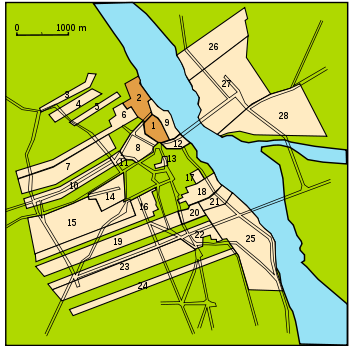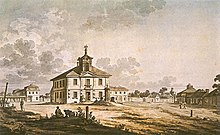Juridiken in Warsaw

1. Warsaw “Old Town”, 2. Warsaw “New Town”, 3. Szymanowska, 4. Wielądka, 5. Parysowska, 6. Świętojerska, 7. Nowolipie , 8. Kapitulna (Zadzikowska), 9. Dziekania, 10. Leszno 11. Tłumackie (Tłomackie) 12. Mariensztadt 13. Dziekanka, 14. Wielopole, 15. Grzybów, 16. Bielino (see also 24), 17. Stanisławów, 18 Aleksandria, 19. Nowoświecka, 20. Ordynacka, 21. Tamka-Kałęczyn, 22. Bożydar-Kałęczyn, 23. Nowogrodzka, 24. Bielino (see also 16), 25. Solec, 26. Golędzinów, 27. Praga, 28. Skaryszew-Kamion


The Juridiken in Warsaw (Polish: Jurydyka , plural Jurydyki ) existed from the 16th to the end of the 18th century. The juridics , which were widespread throughout Poland at the time and were independent of the city's jurisdiction, had a significant impact on Warsaw's urban development . Even today there are traces of its earlier existence in the cityscape.
history
The first juridics in the area around Old Warsaw emerged in the second half of the 16th century and were based on a decree of the Sejm from 1559. This included the spiritual juridics on previously monastic areas such as Świętojerska, Dziekania or Nowogrodzka. Later, wealthy aristocrats in particular founded new settlements outside of the bastion line drawn from 1621. One of the first juridicals owned by a secular lord was Leszno, which was founded in 1648 by Bogusław Leszczyński.
In a list of permanently registered residents in the vicinity of Warsaw in 1792, the 115,000 Warsaw residents at that time were distributed as follows: 66% lived in the old town, 6% in the new town and 28% in the (former) Juridiken, 7% of them on the right bank in Praga. Jewish traders could only settle in Warsaw in the Juridiken. Ten Juridiken had their own town halls, some used their own units of measurement. In 1791 all juridics in Warsaw were abolished and the whole city was administratively divided into seven equal districts.
By the time of its dissolution, in addition to the old town (13th century) and the new town (15th century), 26 juridics had been created in Warsaw :
- Świętojerska, 14th century
- Dziekania, 1402 (founder: dean of the collegiate monastery of St. John)
- Dziekanka (unknown)
- Nowogrodzka, 15th century (founder: Parish of the Holy Spirit, later the Missionaries of the Holy Cross)
- Parysowska, 16th century (founders: Andrzej Parys, Starost von Czersk and Adam Parys, Canon of Kraków )
- Kapitulna (Zadzikowska), 1638 (founder: Jakub Zadzik , Bishop of Cracow and Chancellor of the Grand Crown)
- Novolipie, first half of the 17th century (founder: Monastery of the Order of the Redeemer )
- Szymanowska, first half of the 17th century (founder: M. Szymanowski, Starost von Wyszogród )
- Skaryszew-Kamion, 1641
- Leszno, 1648 (Founders: Bogusław Leszczyński, Under-Treasurer of the Crown and Jan Leszczyński, Chancellor of the Grand Crown)
- Praga, 1648 (founder: Adam Kazanecki)
- Grzybów, 1650 (founder: Jan Grzybowski, Starost of Warsaw)
- Tamka-Kałęczyn, 1659 (founder: Convent of the Sisters of Mercy )
- Nowoświecka, 1659 (founder: Cathedral Chapter of Warsaw)
- Aleksandria, 1670 (founder: Prince Aleksander Zasławski)
- Solec, 1675
- Wielopole, 1693 (founder: Anne de la Grande d'Arquien, widow of the Chancellor of the Grand Crown Jan Wielopolski )
- Wielądka, first half of the 18th century (founder: Adam Wielądek)
- Tłumackie (Tłomackie), 18th century (founder: Eustachy J. Potocki, Starost von Tłumacki)
- Bożydar-Kałęczyn, 1702 (founder: J. Szwarcenberg-Czerny)
- Ordynacka, 1739 (founder: Ordynat by Jan Jakub Zamoyski)
- Bielino, 1757 (Founder: Franciszek Bieliński , Marshal of the Grand Crown)
- Mariensztat, 1762 (founder: Eustachy Potocki, chamberlain and general)
- Golędzinów, 1764 (founder: Stanisław August Poniatowski )
- Bielino, 1766
- Stanisławów, 1768 (founder: Stanisław August Poniatowski)
Individual evidence
- ↑ Werner Huber: Warsaw - Phoenix from the ashes. An architectural city guide , Verlag Böhlau, ISBN 3-412-14105-4 , Cologne 2005, p. 17
- ↑ Tomasz Torbus: Tragic Story . In: Poland: Travel between the Baltic Sea coast and the Carpathian Mountains, Oder and Bug , Cologne, DuMont Reiseverlag, 2002, ISBN 3-770-15287-5 , p. 98 (= DuMont art travel guide )
- ↑ For example, the still existing Plac Grzybowski is a relic of an earlier Juridika, according to Marek Barański and Andrzej Sołtan (see the following individual references)
- ↑ Description to: Marek Barański, Andrzej Sołtan: Warszawa. Ostatnie spojrzenie. Niemieckie fotografia lotnicze spzed sierpnia 1944 (Warsaw - The Last Look. German aerial photographs taken before August 1944) , Muzeum Historyczne m. st. Warszawy (ed.), Warsaw 2004, ISBN 83-88477-23-4
- ^ A b Rafał Jabłoński: Warszawa w kawałkach . In: "Życie Warszawy" from October 29, 2009 (in Polish)
- ↑ a b Gem. Ekaterina Emeliantseva, Warschauer Frankisten (1788–1792) in: Alexandra Binnenkade , Ekaterina Emeliantseva, Svjatoslav Pacholkiv: Familiar and strange at the same time: Jewish-Christian neighborhoods in Warsaw, Lengnau, Lemberg , Böhlau Verlag, Cologne / Weimar 2009, ISBN 3-4122-0177-4 , p. 42 ( Jewish Modernism , Volume 8)
- ↑ Małgorzata Danecka, Thorsten Hoppe: Discover Warsaw. Tours through the Polish capital , Trescher Verlag, Berlin 2008, ISBN 978-3-89794-116-8 , p. 21
literature
- Julius A. Chrościcki and Andrzej Rottermund: Architectural Atlas of Warsaw . Arkady, Warsaw 1978, p. 25
Web links
- Warszawskie Jurydyki at Warszawa1939.pl (in Polish)
- Jurydyka at Warszawa Wikia (in Polish)